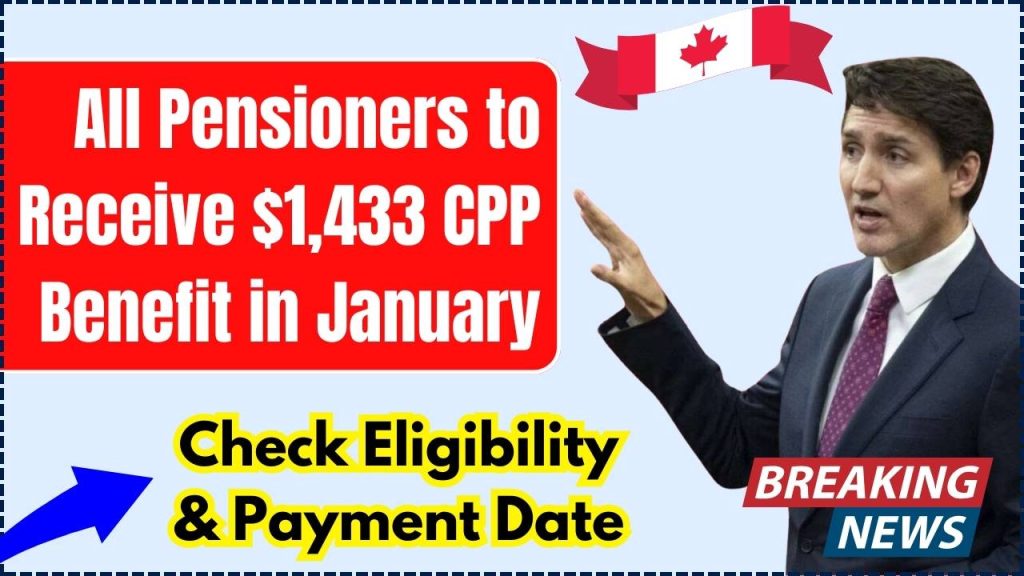
All Pensioners to Receive $1,433 CPP Benefit in January: Starting January 2025, Canadian pensioners can expect significant changes to their Canada Pension Plan (CPP) benefits. The maximum monthly retirement benefit will rise to $1,433, a welcome boost for retirees looking to enhance their financial security.
However, not everyone will qualify for the full amount. In this article, we’ll explore the details of these updates, including eligibility requirements, payment schedules, and practical strategies to maximize your CPP benefits. Whether you’re already retired or planning your future, this guide will provide essential insights to navigate the CPP system confidently.
All Pensioners to Receive $1,433 CPP Benefit in January
| Topic | Details |
|---|---|
| Maximum CPP Monthly Benefit | $1,433 starting January 2025 |
| Eligibility Criteria | Must have contributed to CPP for at least 39 years at maximum levels |
| Contribution Threshold | Year’s Maximum Pensionable Earnings (YMPE) for 2025 is $71,300 |
| Average Monthly Payment | $808.14 for new beneficiaries as of October 2024 |
| First Payment Date in 2025 | January 29, 2025 |
| Official Resource | Canada.ca |
The increase in the maximum CPP monthly benefit to $1,433 in January 2025 is excellent news for Canadian retirees. However, achieving the maximum amount requires careful planning, consistent contributions, and strategic decisions about when to start benefits. By understanding eligibility criteria, payment schedules, and strategies to maximize your benefits, you can make the most of your retirement income and ensure financial stability in your golden years.
What Is the Canada Pension Plan (CPP)?
The Canada Pension Plan is a cornerstone of Canada’s retirement income system. Administered by the federal government, the CPP provides financial support to eligible Canadians during retirement, in cases of disability, or upon the death of a contributor. Contributions are automatically deducted from your paycheck during your working years, with employers matching those contributions. Self-employed individuals are required to cover both the employee and employer portions, making careful financial planning essential for this group.
How Are CPP Benefits Calculated?
The amount you receive depends on:
- Years of Contribution: You must have contributed for at least 39 years to qualify for the maximum amount.
- Contribution Amounts: Contributions are based on your earnings up to the Year’s Maximum Pensionable Earnings (YMPE). For 2025, the YMPE is $71,300.
- Age When You Start Benefits: Starting your pension early reduces your payments, while delaying them increases your benefit. Understanding this balance is critical to optimizing your income.
For example, if you start receiving CPP at age 60, your payments will be reduced by 36%. Conversely, delaying your benefits until age 70 increases your payments by up to 42%, making this an attractive option for those who can afford to wait.
Eligibility for the $1,433 CPP Benefit
While the maximum benefit is $1,433, the majority of Canadians receive less due to varying contribution histories. Here’s a detailed breakdown of what it takes to qualify for the maximum amount:
1. Contribution Requirements
To qualify for the maximum CPP benefit:
- Contribute to CPP for at least 39 years.
- Earn at or above the YMPE for most of those years. This consistent contribution is critical for maximizing your retirement income.
2. Age of Retirement
You can start receiving CPP as early as age 60 or as late as age 70. However:
- Early Retirement (Before 65): Payments are reduced by 0.6% per month (7.2% annually).
- Delayed Retirement (After 65): Payments are increased by 0.7% per month (8.4% annually).
Understanding how your start date affects your benefits is essential for long-term financial planning.
3. Average Payments
Most Canadians do not qualify for the maximum amount. As of October 2024, the average monthly payment for new beneficiaries was $808.14, reflecting the diverse contribution patterns across the workforce.
2025 CPP Payment Schedule
CPP payments are made monthly, offering consistent income for retirees. For 2025, the scheduled dates are:
- January 29, 2025
- February 26, 2025
- March 27, 2025
- April 28, 2025
- May 28, 2025
- June 26, 2025
- July 29, 2025
- August 27, 2025
- September 25, 2025
- October 29, 2025
- November 26, 2025
- December 22, 2025
Mark these dates on your calendar to ensure timely budgeting and financial management. Missing a payment can create unnecessary stress, especially if you rely on CPP as a primary income source.
Maximizing Your CPP Benefits
If you’re aiming for the maximum benefit or simply want to optimize your CPP payments, these strategies can help:
1. Contribute Consistently
Ensure that your earnings meet or exceed the YMPE each year. This consistency is crucial for maximizing your future benefits. Self-employed individuals should carefully plan to meet the higher contribution requirements, as they must pay both portions.
2. Delay Retirement
If possible, delay starting your CPP benefits until after age 65. For example, waiting until age 70 increases your monthly payment by 42%. This approach can significantly enhance your financial stability during later years.
$1,620, $1,950, or $2,700 CPP OAS Payments Confirmed – Find Your January Payment Date!
Canada OAS January 2025: Check Old Age Pension Payment Schedule and Eligibility
Canada GST Payment Update 2025: Check the Next Extra Payment Date, Amount
3. Understand Drop-Out Provisions
The CPP has provisions that exclude low-income years from your calculation. These include:
- Child-Rearing Provision: Excludes years spent caring for young children, allowing parents to avoid penalties for reduced earnings during these periods.
- General Drop-Out: Automatically excludes up to 17% of your lowest-earning years, helping to boost your overall benefit amount.
4. Use the My Service Canada Account
Access your CPP Statement of Contributions to check your contribution history and estimate your retirement benefits. Visit the My Service Canada Account to get started. This resource is invaluable for understanding your CPP entitlements.
FAQs On All Pensioners to Receive $1,433 CPP Benefit in January
1. Who Qualifies for the Maximum CPP Benefit?
To receive $1,433 per month, you must contribute the maximum amount to CPP for at least 39 years. This requires consistent, high-level earnings over your working life.
2. Can I Start CPP Early?
Yes, but starting early reduces your monthly payment by up to 36% if you start at age 60. Delaying until age 70 increases payments by up to 42%, making it a strategic decision based on your financial needs and health outlook.
3. What Happens if I Didn’t Contribute Enough?
Your benefit amount will be lower. However, drop-out provisions can help by excluding years of low or no income from your calculation, potentially increasing your payments.
4. Are CPP Benefits Taxable?
Yes, CPP benefits are considered taxable income. Plan accordingly during tax season to avoid surprises and ensure you’re prepared to meet your obligations.
5. How Do I Apply for CPP?
Apply online through your My Service Canada Account or by mail using the CPP Retirement Pension application form. Early planning ensures a smooth application process.

